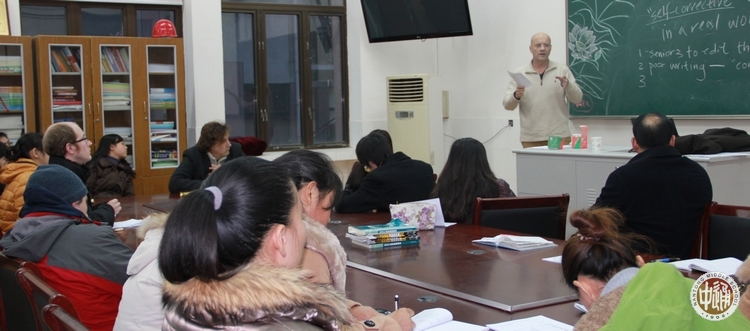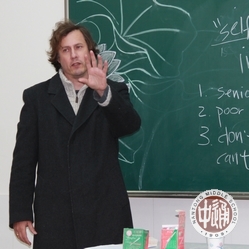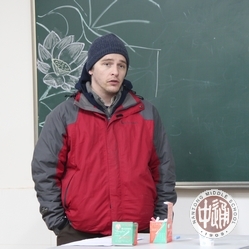|
|
12月21日下午,我校国际教育部举办了“批判性思维在教学中的养成”主题研讨会。 会上,各位老师介绍了自己对批判性思维的认识和理解,并通过具体的教学案例进行解释,与会老师深受启发。 今后,我校将对这一主题进行更深入地研讨和实践。以下文字为Mark M Francis、MaoYiYi、James Stringer、Tomas等老师的发言提纲,供师生参考。 |
|
|
 |
|
【Mark M Francis】Critical thinking
a) Do you teach the students to memorize the answer or teach students to think the answer
b) A test is only one tool and easy to misuse and easy to think that true knowledge has been learn “My students all passed with 100%. Good but did you ask the right questions?”
c) The ability to apply knowledge and skills is the product of critical thinking “ I learn what I needed to pass the test but I do not know how to use it”
d) Ask open questions that force students to relate the different materials they have studied. Do not just ask questions on the information you have given。
e) Build your relationship with your students so that they know that they are free to ask questions and that it is O.K to make mistakes. The only crime is not to try or laziness.
f) Knowledge does not just flow only from the top but grows upwards as well. Encourage and reward those who ask questions and disagree with what you have taught. The teacher who closes down any criticism has lost that student and the class at that moment. If instead you can show you are open to open debate, open to admitting mistakes then you gain your students respect and you lead by example。The response should be “ what’s your evidence I am interested in what you have to say“
Thomas Edison had 3,000 attempts to create the light bulb. When asked about the failures he said "I didn't fail 3,000 times. I found 3,000 ways how not to create a light bulb"
“If you always do what you have always done you will always get what you always got”
【MaoYiYi】Critical thinking: Is a process/procedure for testing the validity of a truth.
1. Ask why
a) Evidence through observation
b) Context
c) Relevant criteria for making judgment well
d) Applicable methods or techniques for forming the judgment
e) Applicable theoretical constructs for understanding the problem and question at hand
2. Scientific method
a) Formulate a question
b) Hypothesis
c) Prediction
d) Test
e) Analysis
3. Be aware of faulty logic
a) Accident/sweeping Generalization
b) Hasty Generalization
c) Irrelevant conclusion
d) Affirming the consequent
e) Begging the question
f) Many questions (Have you stopped beating your wife?)
g) Straw man
h) No true Scotsman
【James Stringer】Goals and Methods for teaching Social Sciences and Humanities classes at Nantong High School
Introduction: The humanities and social sciences provide students with a variety of benefits. They provide practical knowledge for students and expose them to new ideas and information which will build their interests and imagination. However the most important reason to study these topics is to teach students to think about problems and ideas like an American college student will be expected to. The goal is for students to be able to understand, discuss and present abstract ideas.
Problems:
1. Language Barrier
2. Reading and Writing Skills
3. Ability to synthesize and process information from multiple sources
Method:
Step 1: Language Issues: Provide students with vocabulary lists
Step 2: Major questions and issues for the unit
Step 3: Lecture
Step 4: Group Discussion
Step 5: Check Student Understanding
Step 6: Synthesize lecture material with other sources
Step 7: Review
Plans for the Future: If we want to continue to improve our students critical thinking ability we need to give them the resources and instruction to make this possible. This means we need to develop a social studies curriculum to keep building these skills and provide the students with the texts, multi-media, and library resources to make sure they will become successful college students.
【Tomas】Critical Thinking:What do we want to think about, anyway?
Critical thinking is defined in many different ways; it’s an abstract term that may or may not in itself be worth using regarding our students. Roughly speaking, there are 5 qualities associated with the skill of critical thinking:
1. Identify problems correctly and precisely;
2. Gather and evaluate relevant information;
3. Develop solid solutions, testing them against relevant standards;
4. Think open-mindedly from other points of view, considering practical consequences;
5. Communicate clearly with others in devising effective solutions
Richard Paul and Linda Elder, The Miniature Guide to Critical Thinking Concepts and Tools, Foundation for Critical Thinking Press, 2008
As far as Chinese students are concerned, there is a need to efficiently apply learned information to practical situations, not just tests. “Self-corrective thinking in the real world” is how one person explains it. The current situation is one that most students are relating to school information as abstract, only useful for answering test questions. Issues currently reflected in current circumstances: Problems Senior 2 & 3 students reading and writing.
1. Almost all students seem unable to independently edit and improve writing; even the best students will only correct what the teacher edits for them. No one understands the need to raise writing quality through constant revision, practice and polishing; essentially, the teacher has to provide all the editing and improvements, which students copy.
Issue: difficulty self - correcting
2. Most students use big, general words like “knowledge, heart, being kind, being helpful,” rather than being specific about they want to say; this stems from learning a second language, but also not formulating, precisely, what needs to be communicated. It doesn’t seem important to most.
Issue – lack of precision; unclear communication
3. Few students will read carefully and summarize; students are used to reading only to perform on specific tests. They need practice inferring the significance of information in a larger context.
Issue – Ss perceive information as being only valuable for tests
As a teacher, I haven’t identified clear solutions for these problems, other than assuming the burden of correcting. These issues should be discussed and strategies identified with other teachers. However, teachers and Ameson perhaps need to consider the content of what is being taught. Does it serve the needs and priorities of students preparing to enter universities in the United States? Have teachers identified those needs? Do we have the proper tools to address them?





账号+密码登录
手机+密码登录
还没有账号?
立即注册